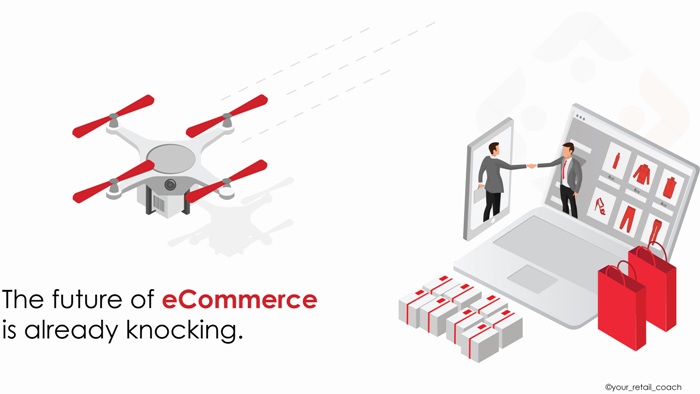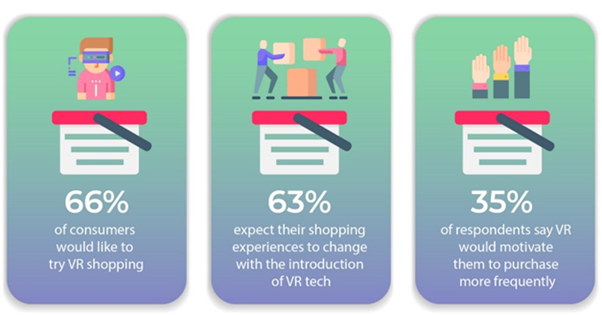Trends in retail eCommerce, future of retail eCommerce
by Your RetailCoach YourRetailCoachReading Time: About 6 minutes

The eCommerce industry has truly and fully arrived. A report published by UNCTAD found that the industry is estimated to be worth $29 trillion. There is no independent country that has not been affected by this sudden upsurge in retail sales due to the convenience and reaches offered by retail eCommerce platforms.
The rise of smartphones worldwide has fuelled the growth of online shopping as now consumers from all around the world can directly order from their smartphones. Companies have started building dedicated mobile apps to tap the potential of eCommerce and also to know their customers better.
But wait, the party has just begun; new eCommerce trends are defining a new direction for the entire industry. In this article, we shall try and understand a few such trends that we believe have already begun to shape up the future of eCommerce.
Increased use of social commerce
The rise of social media platforms like Facebook, WhatsApp, Instagram, Snapchat, and Twitter has helped in increasing the reach of eCommerce many folds leading to the emergence of social shopping. An average user spends about 153 minutes per day browsing through his/her social media feed which is a significant chunk of a day. That is why brands are reaching out to customers on social media platforms. Tech-savvy brands understand the power of social media and have dedicated social media strategies that are handled by expert professionals. To stay ahead of the competition, it has become imperative for businesses to have effective social media strategies.
With their advertising power, social media channels have evolved from just being communication channels to media powerhouses. They have the power to influence buying decisions. With the emergence of the “buy” button on various popular social media platforms, brands are now one step closer to their customers. Tapping on a shoppable post lets the audience view the product description with images, prices and applicable discounts (if any), etc. This has helped businesses in improving the visibility of their brands and products and the likelihood of converting a customer directly from a social media platform. A travel brand, for instance, can easily improve their sales by adding their product stickers on a beautiful photo of a beach or a countryside resort.
Another major trend that is happening right now in social commerce is the rise of influencers. According to a survey, around 17% of internet users reported that they were influenced by social media influencers while making an online purchase decision during the past one month.
Overseas shopping
In this connected world, people are realizing the perks of globalization in the retail industry.
According to a report, around 20% of shopping will be overseas shopping by 2022. This trend is likely to continue as it creates the elusive win-win situation for
Many eCommerce websites are already gearing up to address this challenge by adding multi-currency and multi-language functionality to their websites. This is helping customers in navigating through the website with ease. With global trade increasing by leaps and bounds each year, the trend is expected to continue.
ECommerce personalization
According to ‘The 2017 State of Personalization Report’, around 4 out of 10 consumers in the USA purchased something more expensive because the product was targeted to them in a personalized manner. This is the power of personalization. And let’s face it — we all like attention. It’s this buy button in our brains that gets pushed whenever our favorite brands listen to our needs. Even the smallest adjustments, special prices, personalized notes, or publishing our review on their site holds much importance.
By using omnichannel personalization, brands are building an effective sales funnel, one which caters to both online-aficionados and old-school brick and mortar types.
With the help of sophisticated algorithms, brands are becoming adept in identifying the searching and buying patterns of customers. This helps them in providing targeted advertising, which in turn drives sales. For example, a young mother will be targeted with discount vouchers on diapers as the algorithms know that this is the current top preference for her.
Businesses are going the extra mile in delivering personalized experiences by engaging with customers on their social media handles even after they have made their purchases. Brands are retargeting solutions and re-engaging customers with personalized product recommendations. This is done by tracking the social as well as the online behavior of the customers.
Many tech-savvy brands are utilizing the power of re-targeting on social media by reminding customers about the products that they have left without further action in their shopping carts.
Global business and delivery models
With the fast-changing digital landscape, many innovative businesses and delivery models are taking shape. These models are expected to take a pole position in the future.
One of the most promising business models is dropshipping. This is highly profitable for small and medium-sized eCommerce businesses. The reason for this is that the capital costs are low and you do not have to keep a huge inventory of your products.
Under this model, you either work as a middleman between the producer and the consumer or you are the manufacturer who ships the product to the destination after you receive an order from a seller. The risk of the seller as well as the manufacturer is minimized in this process and hence the model has soared in popularity.
Another popular business model gaining traction is the subscription model. The trendsetter in this domain is one of the pioneers of e-commerce, Amazon. With Amazon Prime, the company has proved that it is possible to get loyal customers using the subscription model. Many e-tailers are expected to follow suit. The beauty of the model lies in its convenience.
Video is the future
With the emergence of video apps like TikTok and growing interest of brands in promoting their products and services in such apps, it is becoming clear that in the future more and more consumers will be targeted for advertisements and making purchase-decisions through video-based advertising apps. The shorter video clips are proving too good to avoid and the time is not far when retailers will be able to directly sell their wares from these video apps by placing targeted advertisements. Making a short video as opposed to lengthy text and presentations about your product is much easier.
In China, we are already witnessing this trend, as TaoBao — China’s largest eCommerce platform, already has 4 out of 10 pages filled with short videos and the company generated more than $15 billion in revenue using the power of live streams. Even Chinese farmers are showcasing their organically-grown food items directly to the consumers via short videos on TaoBao.
Increased usage of AR and VR
Phygital is the new buzzword in eCommerce. The idea of a phygital store is to essentially blur the line between a physical and a digital store.
According to a survey, most of the customers are interested in trying VR (Virtual Reality) shopping. VR shopping is exciting and the immersive experience it provides adds a new dimension to our shopping experience.

With the emergence of affordable hardware options like Google Cardboard, Samsung Gear and Oculus Rift, the sky is the limit for e-commerce firms who want to ace the VR game.
Retailers such as Westfield are already leveraging the power of VR by letting their customers experience the upcoming fashion trends of the season via Oculus Rift.
AR or Augmented Reality is a much affordable option for e-tailers as opposed to VR. It does not require the use of sophisticated technology. In AR, an image is superimposed on a real scene.
The AR catalog app of IKEA is a shining example of AR in action. A major complaint of furniture buyers over decades has been that they do not know whether the furniture they are buying will look good with the interior of their homes or not. IKEA has solved this problem by allowing the customers to select a furniture item from its huge catalog and then superimposing it in their living room. This way the customer can get a much better idea about the aesthetics of the furniture.
Role of retail consulting and eCommerce consultants
Retail eCommerce is a relatively new domain. The already successful models are saturated like that of Amazon or Uber or are barely imitable by SMEs at such scales. Staying afloat requires ideas and thinking that are fundamentally-correct and sustainable whether it is marketing or operations.
A retail eCommerce consultant or an eCommerce agency need not be your guide or mentor. If you see them as business associates, it brings a whole new paradigm into perspective. You need not know everything about retail eCommerce. The same is true for your consultant. But using one another’s experience and expertise could bring in the synergy and a win-win situation for both.
You can also read eCommerce books or follow eCommerce blogs to learn the basics and remain updated. However, considering the option of retail eCommerce consulting might lead you to better identify areas for improvisation in your business.
About us
Your Retail Coach (YRC) is a retail consulting and outsourcing company in India offering a wide range of services in retail offline, retail eCommerce and retail omnichannel catering to a multitude of industries.
Your Retail Coach (YRC) helps retailers and retail enterprises set up their eCommerce business right from planning (eCommerce business plan) to implementation. Our experience and expertise in both offline and online retail channels will help businesses overcome challenges in adopting and running the eCommerce route.
Article Source: https://medium.com/@tweet_yrc/trends-in-retail-ecommerce-future-of-retail-ecommerce-8c4cc903cf1b
Sponsor Ads
Created on Mar 10th 2020 01:08. Viewed 805 times.



